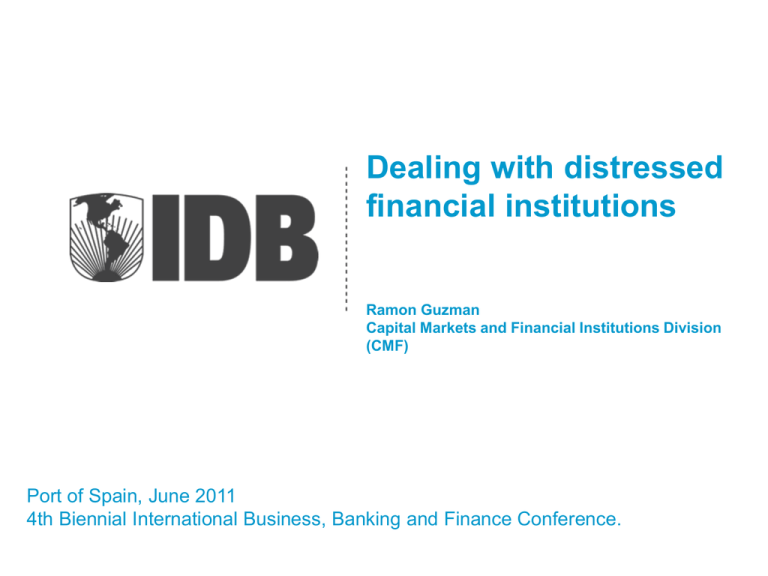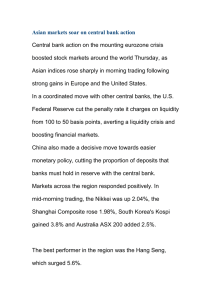Dealing with distressed financial institutions Port of Spain, June 2011
advertisement

Dealing with distressed financial institutions Ramon Guzman Capital Markets and Financial Institutions Division (CMF) Port of Spain, June 2011 4th Biennial International Business, Banking and Finance Conference. Overview How to deal with weak or distressed banks was always a favorite theme in the literature on central banking and supervision. Ample experience in both developing and advanced economies (plenty more now). Reality is messy and action by the authorities rarely complies fully with the norm. Structure of the presentation: – Causes, Phases, Prior Conditions, Principles and Tools for action in case of a bank in distress. – A panoramic view of actions since 2007. Preliminary lessons. -2- Causes of Bank problems Important distinction, symptoms (losses, liquidity shortages, NPL s and asset quality troubles, capital erosion or reputational issues) are not causes. Causes can generally be tracked down to poor management of credit risk (lending standards, excessive risk taking, loan concentration, fraud..), or to the impact of specific risk factors (market risk, liquidity risks, operational risk, legal risks, strategic risks) -3- Causes of Bank troubles • A system to deal with distressed banks is only a piece in the financial safety net. • Effective supervision based on sound prudential regulation (solvency and liquidity rations, internal controls, risk management systems, apropriate accounting and reporting) could help adopt corrective measures and prevent crisis. • Early Warning Systems,availability of information and on site supervision. -4- Phases of the process Strong Regulation and the quality and independence of the Supervision determines the speed and the phases of the intervention Decision making takes place in a continuum within a context of imperfect information. Liquidity and Solvency. Being prudent means understanding: a) Liquidity shortages rarely walk alone, b) There is often no orange light, and c) Costs of denial increase in non linear terms. -5- Prior Conditions for intervention General • Comprehensive forensics: the diagnosis available and un-equivocally requires action. • Full commitment of authorities involved • Clear financial stability objectives is Institutional: A set of powers, operational independence and resources for the authorities involved Legal protection for good faith supervisors Others, a lender of last resort, deposit protection, information sharing rules, an insolvency regime. -6- Principles for a principled intervention General principles • Fair burden-sharing; moral-hazard and minimizing impact on tax payers • Cost efficiency of the solution adopted • Decisivenness and consistency Operational guidelines • Timelinness • Proportionality of the means: always? • Flexibility vs rules • Transparency and accountability: how much? -7- The tool box Individual institution (and system wide) Financial support according to the level and nature of distress (liquidity, emergency liquidity, capital injection, guarantees, asset purchases and/or assumption transactions) Conditionality: restructuring Resolution Options: private sector merger or sale, takeover by the authorities, bailout, receivership. -8- The tool box II Individual institution (and system wide) Some crucial determining factors: risk to system stability, availability of resources, market interest, independence of the authorities. Some more: fiscal and monetary impact, competition policy, legacy issues, international coordination. -9- The tool box III Immediate impacts of the intervention/resolution Restructuring of the Bank: effective surgery should mean no zombies and no bailout. Who pays? Shareholders, subordinated debt holders, management and, ultimately, depositors and senior creditors. How?: Limits to dividend pay out and/or debt redemptions, on compensation practices, and on voting rights. Ultimately, loss in share value or debt haircuts. Removal of management. - 10 - FUENTE: L. Laeven y F.Valencia (IMF Working Paper) - 11 - A BALANCE OF THE MEASURES ADOPTED •Exceptional circumstances have been used to explain why the rule book was set aside. All in all (IMF, March 2011) •Decisive reaction •Success in stabilizing the financial sector, but •Little restructuring involved •Concentration increased •Moral hazard increased •Role of Fiscal and Monetary policy support •Long term: too soon to say. We will have to wait until regulations are overhauled (TBTF, Living Wills etc) - 12 - - 13 -





